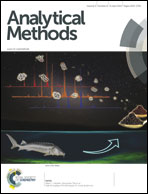A simple model for separation prediction of comprehensive two-dimensional gas chromatography and its applications in petroleum analysis
Abstract
A model has been developed to predict and optimize Comprehensive two-dimensional gas chromatography (GC × GC) separation by simulating GC × GC chromatograms and quantitatively evaluating the separation orthogonality. A custom standard mixture and a light crude oil were used to validate the prediction by the model. It showed that the practical separation was in good agreement with the prediction. With this method, the separation optimization of individual peaks becomes more easy and efficient. Using the optimized separation conditions from the model, some crude oil samples were characterized in detail by GC × GC coupled to time-of-flight mass spectrometry (TOFMS). It showed that the components in the crude oil were separated well under nearly orthogonal conditions and almost spread throughout the whole region of the 2D-plane. Compared with non-orthogonal GC × GC and 1DGC, many new compounds were separated and identified from the co-eluting peaks, some of which are potential biomarkers of petroleum and probably indicate important geochemical information for petroleum exploration. Based on the GC × GC orthogonal separation, some classic geochemical parameters were calculated according to the peak area ratios of individual biomarkers, and compared with results from traditional GC/MS. Basically, more accurate parameters were obtained in orthogonal GC × GC, but good separation of biomarkers in GC/MS could result in close agreement of both methods. Furthermore, owing to the excellent separation of GC × GC in orthogonal conditions, some time-consuming steps of sample preparation proposed in ASTM test methods were simplified greatly by using a homemade device, which can decrease the loss of some components or avoid changing the ratio of compounds during sample preparation.


 Please wait while we load your content...
Please wait while we load your content...